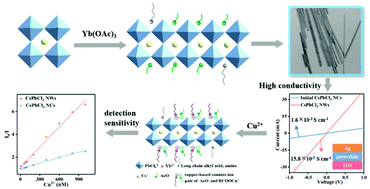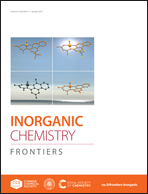Introducing ytterbium acetate to luminescent CsPbCl3 nanocrystals for enhanced sensitivity of Cu2+ detection†
Abstract
In this study, we employed a luminescenct agent CsPbCl3 perovskite nanocrystal for Cu2+ detection, and achieved a prominent enhancement in sensitivity by the introduction of ytterbium acetate (Yb(OAc)3). The introduced Yb(OAc)3 is capable of causing a morphology transformation of CsPbCl3 nanocrystals from initial nanocubes into one-dimensional (1D) nanowires (NWs). The formed 1D CsPbCl3 NWs paved a direct charge transport path and exhibited low defect density as well as superior conductivity, which were beneficial to accelerating the rapid electron transport from the luminescent agent to Cu2+, and to give rise to an efficient inhibition of undesired charge trap, respectively. Besides, AcO− rendered a reduced steric hindrance during the formation of a copper-based counter-ion pair, thus improving the adsorption capacity of Cu2+ on the surface of the luminescent agent, CsPbCl3 nanocrystals. As results, the 1D Yb(OAc)3 passivated CsPbCl3 NWs exhibited efficient luminescence quenching for enhanced detection sensitivity. This Yb(OAc)3-involved system exhibited a detection limit as low as 0.06 nM in the Cu2+ detection window range from 0 to 1000 nM, and such value is optimal in the documented works for Cu2+ detection based on luminescent perovskite materials.



 Please wait while we load your content...
Please wait while we load your content...